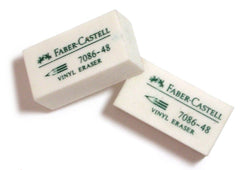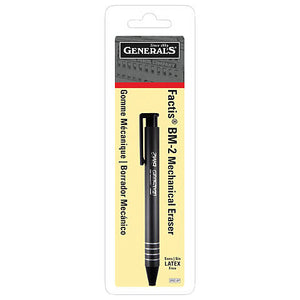- Home
- ERASERS
Erasers

Erasers may be free-standing blocks (block and wedge eraser), or conical caps that can slip onto the end of a pencil (cap eraser). A barrel or click eraser is a device shaped like a pencil, but instead of being filled with pencil lead, its barrel contains a retractable cylinder of eraser material (most commonly soft vinyl). Many, but not all, wooden pencils are made with attached erasers. Novelty erasers made in shapes intended to be amusing are often made of hard vinyl, which tends to smear heavy markings when used as an eraser.
Pink Eraser
Is a standard for most artists. It comes as a wedge shape and is colored pink. Rubber erasers are best suited for erasing pencil (graphite) on paper. It works by shedding itself as it lifts the pigment from the surface. They cleanly erase any pencil marks and do not leave the smudge mark behind.
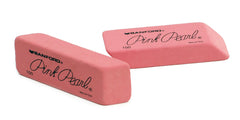
Artist's Gum Eraser
The stylized word "Art gum" was first used in 1903 and trademarked in the United States in 1907. That type of eraser was originally made from oils such as corn oil vulcanized with sulfur dichloride although may now be made from natural or synthetic rubber or vinyl compounds. It is very soft yet retains its shape and is not mechanically plastic, but crumbles as it is used. It is especially suited to cleaning large areas without damaging the paper. However, they are so soft as to be imprecise in use. The removed graphite is carried away in the crumbles, leaving the eraser clean, but resulting in a lot of eraser residue. This residue must then be brushed away with care, as the eraser particles are coated with the graphite and can make new marks. Art gum erasers are traditionally tan or brown, but some are blue.
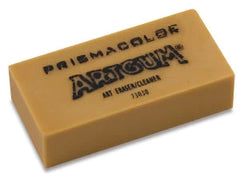
Cap Erasers
Originally made from natural rubber, but now usually from cheaper SBR, this type contains mineral fillers and an abrasive such as pumice with a plasticizer such as vegetable oil. They are relatively hard (in order to remain attached to the pencil) and frequently colored pink. They can also be permanently attached to the end of a pencil with a ferrule.
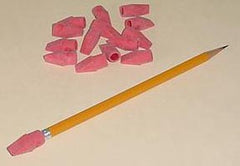
Elastomer Erasers
In these types, a thermoplastic elastomer combines a styrene resin elastomer and an olefin resin. These erasers have better erasability for erasing pencil marks compared to conventional vinyl erasers. Elastomers can be formed into thin cylindrical or other shapes to be used as extendable erasers.
Kneaded Erasers
Kneaded erasers (called putty rubbers outside the United States) have a plastic consistency and are common to most artists' standard toolkit. They can be pulled into a point for erasing small areas and tight detail erasing, molded into a textured surface and used as a reverse stamp to give texture, or used in a "blotting" manner to lighten lines or shading without completely erasing them. They gradually lose their efficacy and resilience as they become infused with particles picked up from erasing and from their environment. They are not suited to erase large areas because of their tendency to deform under vigorous erasing.

Sand (Silica) Erasers
High-quality erasers made of natural rubber latex and silica grit. These erasers are designed to remove colored pencil and ink marks, including ballpoint, rollerball, and some marker. Their abrasive texture can damage paper if used too hard or too much in one spot. Non-PVC and phthalate-free.
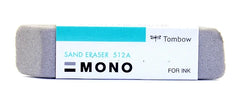
Vinyl (Plastic, Polymer) Erasers
High-quality plasticized vinyl or other "plastic" erasers, originally trademarked Mylar in the mid-20th century, are softer, non-abrasive, and erase cleaner than standard rubber erasers. This is because the removed graphite does not remain on the eraser as much as rubber erasers but is instead absorbed into the discarded vinyl scraps. Being softer and non-abrasive, they are less likely to damage canvas or paper. Engineers favor this type of eraser for work on technical drawings due to their gentleness on paper with less smearing to surrounding areas. They often come in white and can be found in a variety of shapes.
